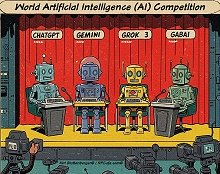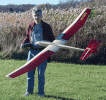Electronics & High Technology Components
- See Full List of AI Topics -
An electrical
transducer is a device that converts one form of energy into an electrical signal.
This transformation allows for the measurement, detection, or communication of various
physical phenomena. Transducers play a critical role in a wide range of applications
across different fields, including engineering, physics, biology, and more. They
are essential for sensing, control, monitoring, and communication systems.
There are various types of electrical transducers, each designed to convert specific
types of physical quantities into electrical signals. Some common types of electrical
transducers include:
Pressure Transducers: These convert pressure variations into electrical signals.
They are used in applications such as industrial processes, automotive systems,
and medical equipment.
Temperature Transducers: These convert temperature changes into electrical signals.
Thermocouples and resistance temperature detectors (RTDs) are examples of temperature
transducers.
Strain Transducers: These measure the deformation or strain experienced by a
material and convert it into an electrical signal. Strain gauges are commonly used
in engineering applications to monitor structural integrity and stress levels.
Light Sensors (Photodetectors): These convert light intensity variations into
electrical signals. Photodiodes, phototransistors, and solar cells are examples
of light sensors.
Accelerometers: These convert acceleration or vibration into electrical signals.
They are used in various applications, including inertial navigation systems, automotive
airbag deployment, and vibration analysis.
Microphones: These convert sound waves into electrical signals. They find use
in audio recording, telecommunications, and speech recognition systems.
Ultrasonic Transducers: These convert high-frequency sound waves (ultrasound)
into electrical signals and vice versa. They are used in medical imaging (ultrasound
imaging), distance measurement, and industrial testing.
Magnetic Transducers: These convert changes in magnetic fields into electrical
signals. Hall effect sensors and magnetometers are examples of magnetic transducers.
Gas Sensors: These detect the presence and concentration of specific gases in
the environment by converting gas interactions into electrical signals. They are
used in environmental monitoring, safety systems, and industrial processes.
Position and Displacement Transducers: These measure the position or displacement
of an object and convert it into an electrical signal. Linear variable differential
transformers (LVDTs) and rotary encoders are examples of position transducers.
 This content was generated by primarily
the ChatGPT (OpenAI), and/or
Gemini (Google), and/or
Arya (GabAI), and/or
Grok 3 (x.AI) artificial intelligence (AI) engine.
Some review was performed to help detect and correct any inaccuracies; however,
you are encouraged to verify the information yourself if it will be used for critical
applications. In some cases, multiple solicitations to the AI engine(s) was(were) used to assimilate
final content. Images and external hyperlinks have also been added occasionally.
Courts have ruled that AI-generated content is not subject to copyright restrictions,
but since I modify them, everything here is protected by RF Cafe copyright. Many
of the images are likewise generated and modified. Your use of this data implies
an agreement to hold totally harmless Kirt Blattenberger, RF Cafe, and any and all
of its assigns. Thank you. Here are the major categories. This content was generated by primarily
the ChatGPT (OpenAI), and/or
Gemini (Google), and/or
Arya (GabAI), and/or
Grok 3 (x.AI) artificial intelligence (AI) engine.
Some review was performed to help detect and correct any inaccuracies; however,
you are encouraged to verify the information yourself if it will be used for critical
applications. In some cases, multiple solicitations to the AI engine(s) was(were) used to assimilate
final content. Images and external hyperlinks have also been added occasionally.
Courts have ruled that AI-generated content is not subject to copyright restrictions,
but since I modify them, everything here is protected by RF Cafe copyright. Many
of the images are likewise generated and modified. Your use of this data implies
an agreement to hold totally harmless Kirt Blattenberger, RF Cafe, and any and all
of its assigns. Thank you. Here are the major categories.
Electronics & High Tech
Companies | Electronics &
Tech Publications | Electronics &
Tech Pioneers | Electronics &
Tech Principles |
Tech Standards Groups &
Industry Associations | Societal
Influences on Technology
|









